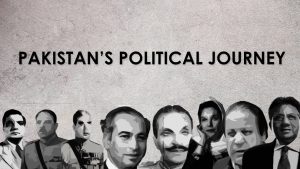
The history of Pakistani politics can be traced back to the formation of Pakistan as a sovereign state in 1947. Since then, Pakistan has undergone several phases of political evolution, marked by military coups, civilian rule, constitutional amendments, and socio-economic changes.
Following the partition of British India in 1947, Pakistan emerged as an Islamic republic, with Muhammad Ali Jinnah as its first Governor-General. The country adopted a parliamentary system of government, with the Muslim League as the ruling party. However, political instability and economic challenges marked the early years of Pakistan’s existence.
In 1958, General Ayub Khan, the then Chief of Army Staff, seized power in a military coup and established a dictatorship. He introduced a presidential system of government and initiated rapid economic growth, but his rule was marred by corruption and suppression of dissent.
In 1969, General Yahya Khan replaced Ayub Khan in another military coup, and assumed power as the President of Pakistan. However, his tenure was short-lived, as he oversaw the country’s first democratic elections in 1970, which led to the separation of East Pakistan (now Bangladesh) and a civil war.
In 1971, Zulfikar Ali Bhutto, the leader of the Pakistan People’s Party (PPP), became the country’s first democratically elected Prime Minister. His government undertook significant social and economic reforms, including the nationalization of major industries and the adoption of a new constitution that recognized Pakistan as an Islamic republic.
In 1977, General Zia-ul-Haq ousted Bhutto in a military coup and established a military dictatorship that lasted for over a decade. Zia-ul-Haq introduced a series of Islamization measures and strengthened Pakistan’s ties with the United States during the Cold War.
In 1988, following Zia-ul-Haq’s death in a plane crash, a new era of civilian rule began under the leadership of Benazir Bhutto, Zulfikar Ali Bhutto’s daughter. She was elected as Prime Minister twice, but her government was marred by corruption scandals and political instability.
In 1999, General Pervez Musharraf seized power in a bloodless military coup and ruled Pakistan until 2008. He introduced significant reforms, including the devolution of power to local governments, but his rule was also marked by restrictions on freedom of speech and a crackdown on dissent.
In 2008, democratic rule was restored in Pakistan, and the PPP won the general elections. Asif Ali Zardari, Benazir Bhutto’s widower, became the President of Pakistan, and Yousaf Raza Gillani was appointed as the Prime Minister. However, the government faced significant challenges, including political instability, economic crises, and security threats from extremist groups.
In 2013, the Pakistan Muslim League-Nawaz (PML-N) won the general elections, and Nawaz Sharif became the Prime Minister for the third time. His government focused on infrastructure development and economic reforms, but his tenure was cut short by a Supreme Court decision that disqualified him from holding public office due to corruption charges.
In 2018, Imran Khan, a former cricketer, led his party, the Pakistan Tehreek-e-Insaf (PTI), to victory in the general elections. He became the country’s Prime Minister, promising to tackle corruption, improve governance, and promote economic growth. His government has faced significant challenges, including economic crises, political opposition, and security threats from extremist groups.
Overall, the history of Pakistani politics has been marked by a complex interplay of democratic and authoritarian forces, with military coups, civilian rule, constitutional amendments, and socio-economic changes shaping the country’s political landscape.